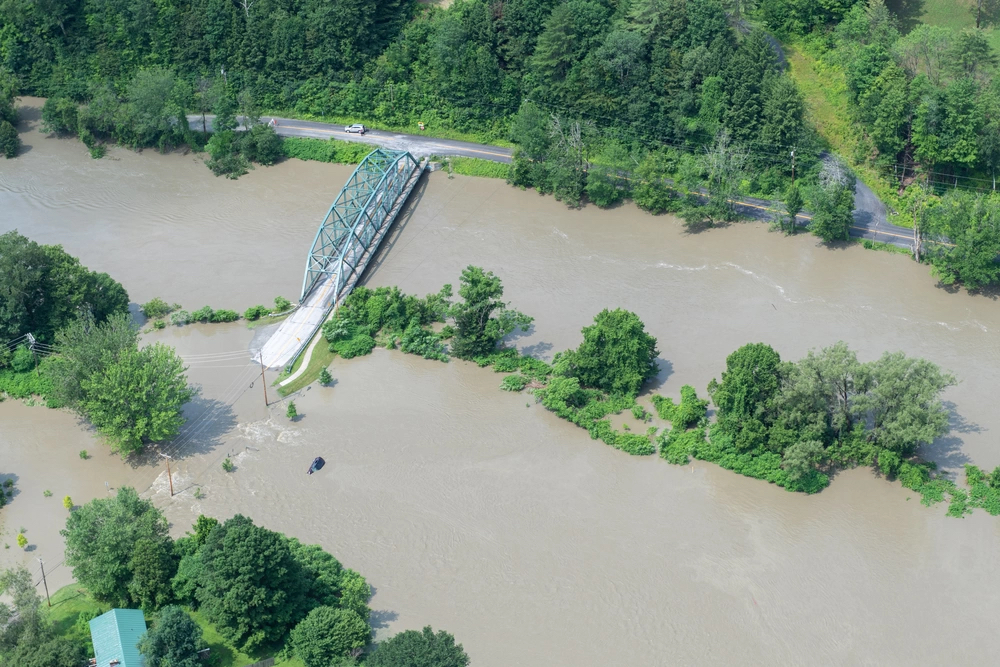What we’re watching: Weekly disaster update, July 17

We know all too well that disaster can strike anytime, anywhere in the world. Some disasters make headlines; others do not. Here at the Center for Disaster Philanthropy (CDP), we monitor the status of disasters worldwide and compile a list of the ones we’re tracking weekly, along with relevant disaster-related media coverage.
Here’s what we’re watching for the week of July 17, 2023.
New or Emerging Disasters
Flooding – U.S. Northeast: Heavy rain in the northeastern U.S. brought flooding and related storm impacts to several states, including New York, Vermont, Massachusetts and Connecticut. Vermont received two months’ worth of rain, more than nine inches, in a few days. Water levels were higher than in 2011’s Hurricane Irene, which devastated the state. The National Weather Service (NWS) said New York’s Hudson Valley received between five and eight inches of rain.
The flooding destroyed homes and businesses, washed away cars, roads and bridges, and impacted critical infrastructure. Officials in Vermont said a man drowned in his home, the first death linked to the flooding in parts of the state. NWS had a flood watch in place for most of Vermont through the night of July 16.
On July 14, President Biden approved a major disaster declaration for Vermont in response to the severe storms and flooding. The declaration (DR-4720) includes Individual Assistance for six counties and Public Assistance-B for 14 counties as of July 17.
CDP’s Sally Ray wrote in the aftermath of the floods, “Philanthropy must listen to communities to fully understand their long-term needs and to help address them and prepare these communities for future climate-caused disasters.”
For more, see our 2023 Northeast US Floods disaster profile.
Flooding – Pennsylvania: Flash floods across southeastern Pennsylvania killed at least five people. Some of the worst flooding occurred in Bucks County, north of Philadelphia and near the New Jersey border. Upper Makefield Township Fire Chief Tim Brewer said up to seven inches of rain fell within two hours across parts of the area.
Flooding – South Korea: The country’s rainy season started in late June and is reaching its peak as heavy rainfall affected the central and southern regions since July 13. The storm’s death toll reached 40, including a dozen people found dead in a submerged underpass. South Korean President Yoon Suk Yeol blamed the underpass deaths on authorities’ failure to follow disaster response rules. Yoon also said he would “completely overhaul” the country’s approach to extreme weather as “these events will become more commonplace.”
Public Health Emergency – Peru: On July 8, the Presidency of the Republic of Peru declared a health emergency at the national level due to the unusual increase in cases of Guillain Barré Syndrome (GBS), a rare neurological disorder. Through July 7, the country saw 77 confirmed cases, including four deaths. In 2019, Peru reported an outbreak of GBS that affected several regions. The disorder is not contagious or inherited. Peru is also experiencing a dengue outbreak partly related to the unusual temperature increase.
Wildfire – California: Firefighters in southern California are battling several fires that started on July 14 amid a heatwave. The fires were located in primarily rural areas across Riverside County. CalFire said almost 1,000 homes were under evacuation orders, but there were no immediate reports of injuries or loss of property.
The largest is the Rabbit Fire, which burned 7,600 acres and was 35% contained as of July 17. Triple-digit temperatures and complex topography are proving challenging for crews.
Previous/Ongoing Disasters
Complex Humanitarian Emergency – Sudan: Martin Griffiths, the United Nations (UN) Under-Secretary-General for Humanitarian Affairs and Emergency Relief Coordinator, said in a July 15 statement, “As the conflict enters its fourth month, the battle lines are hardening, making it ever more difficult to reach the millions of people who need urgent humanitarian assistance.”
The conflict between the Sudanese army and the paramilitary Rapid Support Forces (RSF) continues. While there are ongoing attempts at peace talks and de-escalating the fighting by regional and global powers, there seems to be little interest among the parties to the conflict to come to the table meaningfully.
As food prices rise, the humanitarian situation is deteriorating for people in Khartoum, Darfur, and other areas with little access to healthcare, water and electricity. The conflict has displaced 3.1 million people, including 2,414,625 inside Sudan and 659,124 in neighboring countries. The World Food Programme said thousands are entering Chad, with reports indicating that people fleeing are being deliberately targeted “with an increasing ethnic dimension to the violence.”
For more, see our Sudan Humanitarian Crisis disaster profile.
Wildfires – Canada: An unprecedented combination of heat, fire and dangerous smoke plumes continue to affect large parts of Canada. On June 27, Canada surpassed the record set in 1989 for the total area burned in one wildfire season. Record heat is affecting even the typically cooler northern territories.
According to data from the Canadian Interagency Forest Fire Centre, there were 881 active fires across the country on July 17. A firefighter died from injuries sustained while fighting a fire in the Northwest Territories on July 15.
The wildfires in Canada are once again expected to bring increased air pollution to the U.S. this week. Around 70 million people could be under air quality alerts.
For more, see our 2023 North American Wildfires disaster profile.
In addition to the disasters listed above, we actively monitor the following disasters or humanitarian emergencies. For more information, see the relevant disaster profiles, which are updated regularly.
- Afghanistan Humanitarian Crisis
- Horn of Africa Hunger Crisis
- 2023 US Tornadoes
- 2023 Turkey-Syria Earthquake
- Ukraine Humanitarian Crisis
U.S. Midwest Low-Attention Disasters
The Midwest is regularly faced with low-attention disasters that affect people across the region. CDP’s Midwest Early Recovery Fund (ERF) effectively funds efforts that catalyze equitable disaster recovery.
These are some of the latest disasters and related news the ERF team is monitoring:
- At the end of June, a storm dumped more than six inches of rain on the small town of Hardin, Montana, in the eastern part of the state. The water has subsided, but survivors are struggling with recovery after the storm damaged at least 16 homes.
Complex Humanitarian Emergencies – Central African Republic (CAR)
Many places worldwide are experiencing emergencies caused by conflict, climate change, drought, famine, economic challenges and other conditions that combine to create a complex humanitarian emergency (CHE). CDP maintains complete profiles on several CHEs, and what CDP considers Level 1 CHEs are profiled in this weekly blog post and tracked.
The top United Nations (UN) official in CAR said in June the humanitarian situation in the country remains critical, with more than half the population requiring assistance. Fighting between armed groups has forced one in five people from their homes, and essential services are often unavailable.
Conflict and subsequent violence have persisted for over a decade, and human rights violations are constant. More than 50% of Central Africans are not eating enough, and the country has one of the world’s highest proportions of critically food-insecure people.
The conflict in neighboring Sudan is exacerbating needs. The humanitarian plan for the country was amended to include support for Sudanese and CAR nationals fleeing Sudan and the communities hosting them.
UN peacekeepers were deployed to CAR in 2014 to help end intercommunal violence that started when mainly Muslim militants ousted the then-president, prompting retaliations from primarily Christian militias. In July, a Rwandan peacekeeper was killed in an attack while on patrol in the northeast part of the country.
Upcoming webinar
Aug. 10: Disaster case management: Navigating recovery one person at a time

What We’re Reading
- Localised disaster responses show promise for Pacific Island countries facing extreme climate events – UNSW Sydney: The Resilience Project, a multi-stakeholder collaboration, researched the Pacific region’s disaster recovery responses concerning rapid urbanization. The research found that area-based approaches – community-led responses to geographically targeted disasters, flexible and participatory in program design – could help foster resilience, community identity and responsibility, and locally tailored risk-reduction strategies.
- UN warns its development goals for 2030 are in trouble and 575 million people will remain very poor – The Associated Press: In a report on progress on the UN’s 2030 sustainable development goals, the global organization said halfway through the 15-year time frame, not a single one of the goals is on target to be met. The goals, which the authors described as “an ethical imperative,” cover threats to the climate and environment and basic human rights such as food, health and education.
- LGBTQI+ rights are not just for Pride Month – ODI: The authors outline three critical areas for action on supporting systemic responses to effectively counter an emboldened anti-rights movement: promoting feminist foreign policy, responding to LGBTQI+ rights in crises and countering fear-based narratives.
- State of Nonprofits 2023: What Funders Need to Know – Center for Effective Philanthropy: “Many nonprofits are experiencing more trust from their funders and changed practices related to funding type as well as processes, indicating that many of the shifts in funder practices that began in 2020 have continued. Even as nonprofit leaders experience these shifts in practice, however, they name their top challenge as a series of interconnected issues related to burnout and hiring and retaining staff.”
- In Oregon Timber Country, a Town Buys the Surrounding Forests to Confront Climate-Driven Wildfires – Inside Climate News: “Conventional wisdom in the region would have Butte Falls try to reclaim its former glory as a logging hub. But community leaders have hatched an ambitious plan to protect their future by looking to the forest itself as a source of protection as much as prosperity.”
The Colorado Pika Project is looking for citizen scientists to use its Pika Patrol app to contribute to a growing database of cute mountain creatures.

